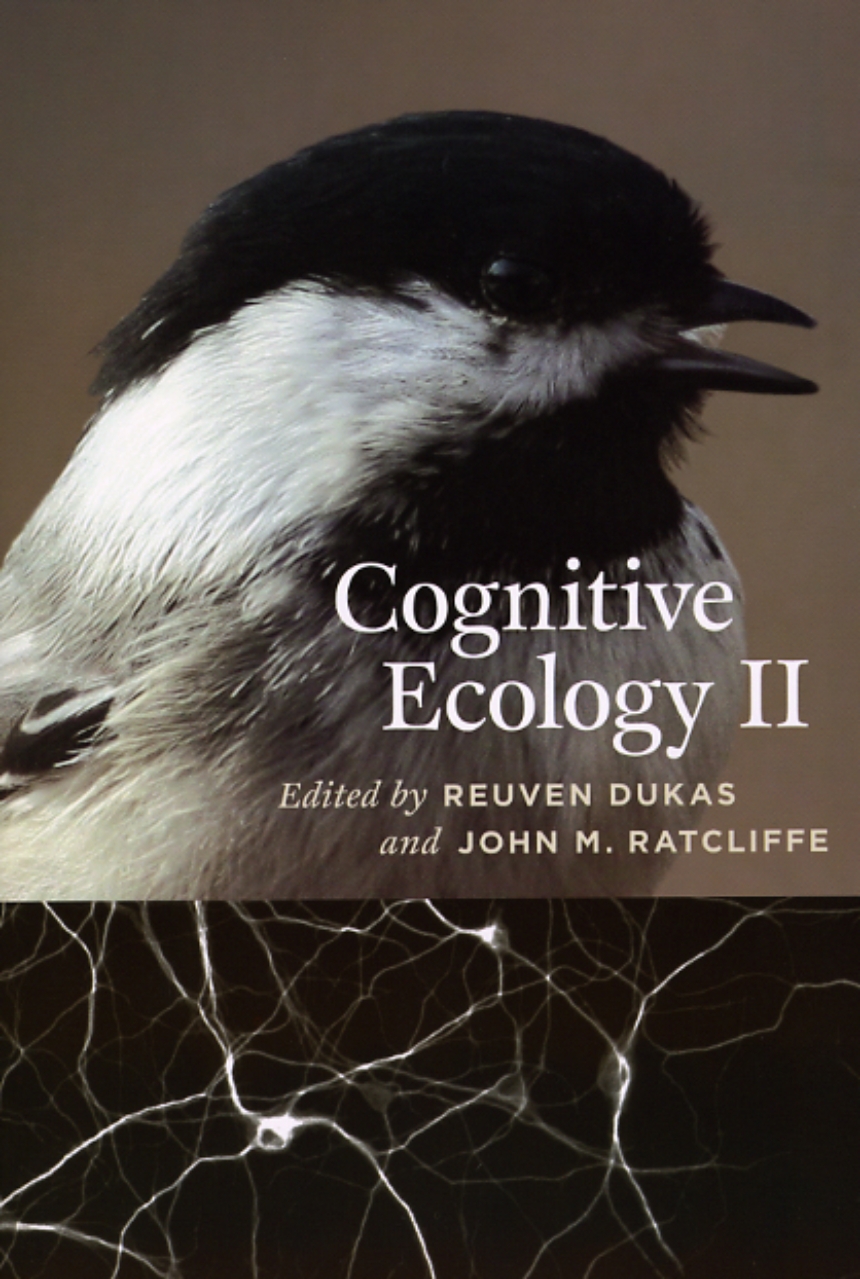Cognitive Ecology II
Merging evolutionary ecology and cognitive science, cognitive ecology investigates how animal interactions with natural habitats shape cognitive systems, and how constraints on nervous systems limit or bias animal behavior. Research in cognitive ecology has expanded rapidly in the past decade, and this second volume builds on the foundations laid out in the first, published in 1998.
Cognitive Ecology II integrates numerous scientific disciplines to analyze the ecology and evolution of animal cognition. The contributors cover the mechanisms, ecology, and evolution of learning and memory, including detailed analyses of bee neurobiology, bird song, and spatial learning. They also explore decision making, with mechanistic analyses of reproductive behavior in voles, escape hatching by frog embryos, and predation in the auditory domain of bats and eared insects. Finally, they consider social cognition, focusing on alarm calls and the factors determining social learning strategies of corvids, fish, and mammals.
With cognitive ecology ascending to its rightful place in behavioral and evolutionary research, this volume captures the promise that has been realized in the past decade and looks forward to new research prospects.
384 pages | 45 halftones, 52 line drawings, 5 tables | 6 x 9 | © 2009
Biological Sciences: Behavioral Biology, Biochemistry, Biology--Systematics, Ecology, Evolutionary Biology, Physiology, Biomechanics, and Morphology
Cognitive Science: Human and Animal Cognition, Neuroscience
Reviews
Table of Contents
Acknowledgments
1 Introduction
Reuven Dukas & John M. Ratcliffe
Part I Learning: Ultimate and Proximate Mechanisms
2 Learning: Mechanisms, Ecology, and Evolution
Reuven Dukas
2.1 Introduction • 2.2 What is learning? • 2.3 Why learn? • 2.4 Who learns? • 2.5 What do animals learn? • 2.6 Is learning important? • 2.7 Prospects
3 The How and Why of Structural Plasticity in the Adult Honeybee Brain
Susan E. Fahrbach & Scott Dobrin
3.1 Introduction • 3.2 The honeybee as a model for the study of neural plasticity •
3.3 Mushroom bodies: Neuroanatomy • 3.4 How does foraging experience change the structure of the honeybee mushroom bodies? • 3.5 What is the function of the honeybee mushroom bodies? • 3.6 Why are the mushroom bodies larger in experienced foragers? • 3.7 Studies of experience-dependent plasticity in the mushroom bodies of other insects • 3.8 Specific future directions
Part II Avian Cognition: Memory, Song, and Innovation
4 More on the Cognitive Ecology of Song Communication and Song Learning in the Song Sparrow
Michael D. Beecher & John M. Burt
4.1 Introduction • 4.2 Background • 4.3 Song learning in the field • 4.4 Communication by song in male-male interactions • 4.5 Social eavesdropping hypothesis • 4.6 Discussion • 4.7 Summary
5 Consequences of Brain Development for Sexual Signaling in Songbirds
William A. Searcy & Stephen Nowicki
5.1 Introduction • 5.2 The song system • 5.3 Female preferences for song attributes • 5.4 Experimental tests of the developmental stress hypothesis • 5.5 Effects of developmental stress on phenotypic quality • 5.6 Conclusions and prospects
6 Development of Spatial Memory and the Hippocampus under Nutritional Stress: Adaptive Priorities or Developmental Constraints in Brain Development?
Vladimir V. Pravosudov
6.1 Introduction • 6.2 Spatial memory and the hippocampus in birds • 6.3 Nutritional deficits during posthatching development, spatial memory, and the hippocampus in western scrub jays • 6.4 Nutritional deficits during postnatal development and the hippocampus in mammals • 6.5 Hippocampus and song nuclei in birds • 6.6 Does lack of nutrition directly cause changes in the brain? • 6.7 Stem cells • 6.8 Conclusions
7 The Cognitive-Buffer Hypothesis for the Evolution of Large Brains
Daniel Sol
7.1 Introduction • 7.2 Assumptions of the cognitive-buffer hypothesis • 7.3 Predictions of the cognitive-buffer hypothesis • 7.4 Synthesis • 7.5 Avenues for future research • 7.6 Summary
Part III Decision Making: Mate Choice and Predator-Prey Interactions
8 Cognitive Mate Choice
Michael J. Ryan, Karin L. Akre & Mark Kirkpatrick
8.1 Introduction • 8.2 Detection and perception • 8.3 Evaluation and decision • 8.4 Conclusions and future directions
9 Monogamous Brains and Alternative Tactics: Neuronal V1aR, Space Use, and Sexual Infidelity among Male Prairie Voles
Steven M. Phelps & Alexander G. Ophir
9.1 Introduction • 9.2 Reproductive decisions, space use, and mating tactics • 9.3 Neural substrates of alternative tactics • 9.4 Microsatellite polymorphisms and phenotypic diversity • 9.5 Monogamy and cognitive ecology reconsidered
10 Assessing Risk: Embryos, Information, and Escape Hatching
Karen M. Warkentin & Michael S. Caldwell
10.1 Introduction • 10.2 Cognitive strategies to assess risk using nonstereotyped cues • 10.3 Adaptive responses of embryos in heterogeneous environments • 10.4 Hatching decisions: Information use by red-eyed treefrog embryos • 10.5 Conclusions and future directions
11 Predator-Prey Interaction in an Auditory World John M. Ratcliffe
11.1 Of bats and moths and coevolution • 11.2 Sensory ecology and behavioral flexibility of predatory bats • 11.3 Neuroethology of auditory-evoked defenses in noctuoid moths • 11.4 Bat detection and the primary and secondary defenses of moths • 11.5 Summary and conclusions
Part IV Cognition and Sociality
12 What Do Functionally Referential Alarm Calls Refer To?
Marta B. Manser
12.1 Introduction • 12.2 Meerkat alarm calls • 12.3 What do functionally referential
alarm calls refer to? • 12.4 Why are some alarm calls considered functionally referential and not others? • 12.5 Can functionally referential calls be explained by emotional expression of the signaler? • 12.6 Conclusions • 12.7 Summary
13 Adaptive Trade-offs in the Use of Social and Personal Information
Rachel L. Kendal, Isabelle Coolen & Kevin N. Laland
13.1 Introduction • 13.2 “When” strategies • 13.3 “Who” strategies • 13.4 Evolutionary implications • 13.5 Summary and future directions
14 The 3E’s Approach to Social Information Use in Birds: Ecology, Ethology, and Evolutionary History
Ira G. Federspiel, Nicola S. Clayton & Nathan J. Emery
14.1 Introduction • 14.2 Case studies • 14.3 Conclusions
15 Prospects
Reuven Dukas & John M. Ratcliffe
References
Contributors
Index
